Eel
Interesting Facts
Japanese eels, Anguilla japonica, can surmount a 46-m-high natural waterfall.
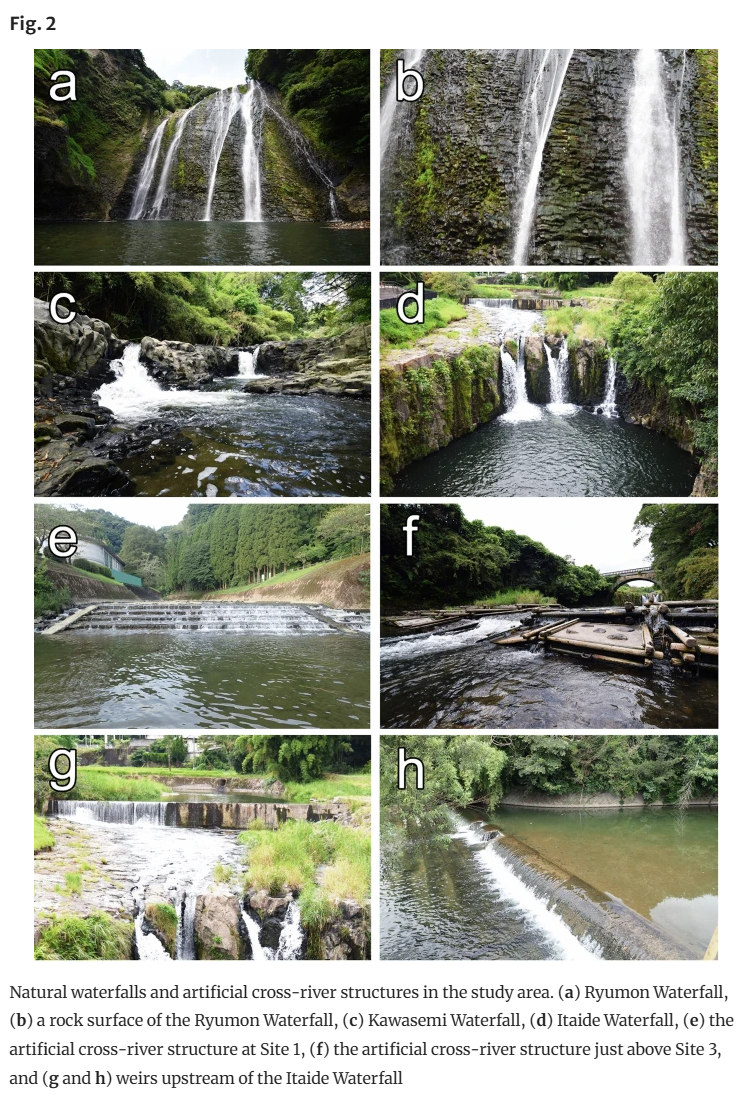
Matsushige, Kazuki, Yusuke Hibino, Yoshiya Yasutake, and Noritaka Mochioka. “Japanese Eels, Anguilla Japonica, Can Surmount a 46-M-High Natural Waterfall of the Amikake River System of Kyushu Island, Japan.” Ichthyological Research 68, no. 1 (2021): 21–31. https://doi.org/10/g62g23.
In Switzerland, specimens have been taken in waters at an altitude of 3000 feet (925m) above the level of the sea.
Schmidt, Johs. “The Breeding Places of the Eel.” Philosophical Transactions of the Royal Society of London. Series B, Containing Papers of a Biological Character 211, no. 382–390 (1923): 179–208. https://doi.org/10/dc9gpq.
"Given their catadromous life-cycle, and global commercial and cultural importance, as a taxa, anguillid eels can act as indicator, umbrella and flagship species, and a comprehensive surrogate for conservation of freshwater biodiversity."
Itakura, Hikaru, Ryoshiro Wakiya, Matthew Gollock, and Kenzo Kaifu. “Anguillid Eels as a Surrogate Species for Conservation of Freshwater Biodiversity in Japan.” Scientific Reports 10, no. 1 (2020): 8790. https://doi.org/10/jknd.
Regarding Anguilla megastoma (Polynesian eel), from IUCN Red List note: "Many are found at higher altitudes – the indigenous name in Tahiti is puhi-mauá (eel of the mountains) – and Schmidt (1927) reported that this species can traverse obstacles by leaving the water and crawling over the moist terrain. Individuals sampled in Lake Letas, 7 km inland on Gaua Island, Vanuatu, must have overcome Siri Falls (120 m high) as elvers in order to reside there."
In Australia, elvers make a journey around the 140 metre tall Warragamba Dam to Lake Burragorang. Scientists track amazing eel migration
List of Species
- A. oelebesensis
- A. interioris
- A. megastoma
- A. anoestralis
- A. nebulosa nebulosa
- A. nebulosa labiata
- A. marmorata
- A. reinhardtii
- A. borneensis
- A. japonioa
- A. rostrata
- A. anguilla
- A. dieffenbaohii
- A. mossambioa
- A. bioolor paoifioa
- A. bioolor bioolor
- A. obsoura
- A. australis australis
- A. australis sohmidtii
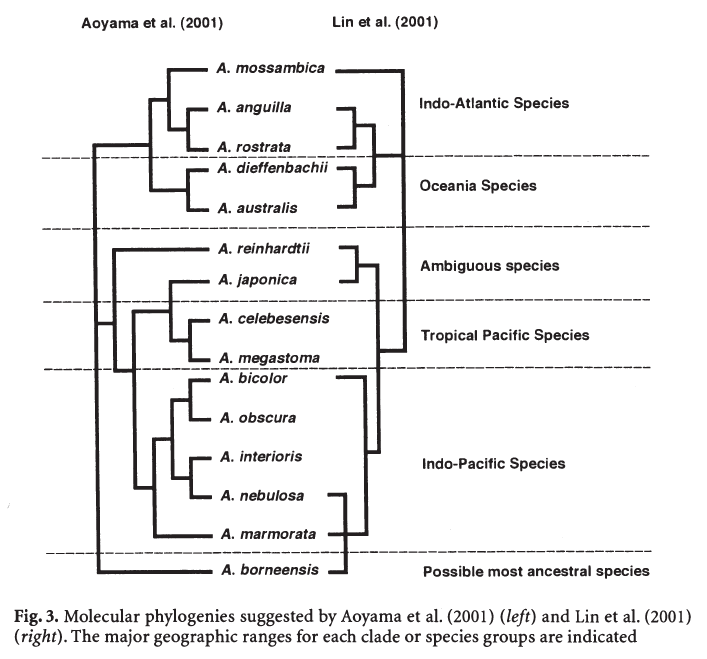
Aoyama, Jun. ‘Origin and Evolution of the Freshwater Eels, Genus Anguilla’. In Eel Biology, edited by Katsumi Aida, Katsumi Tsukamoto, and Katsumi Yamauchi. Tokyo: Springer, 2003.
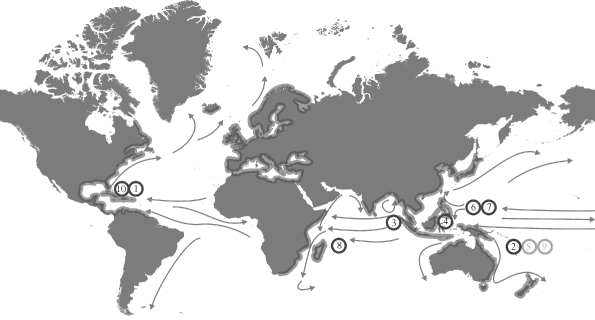
Known or suspected spawning sites for well-studied Anguilla spp.: 1, A. anguilla; 2, A. australis; 3, A. bengalensis; 4, A. celebesensis; 5, A. dieffenbachii; 6, A. japonica; 7, A. marmorata; 8, A. mossambica; 9, A. reinhardtii; 10, A. rostrata. The coasts of regions colonized by them are shaded grey. Warm currents that are likely to carry larval Anguilla spp. from spawning areas to the growth habitat are shown by arrows.
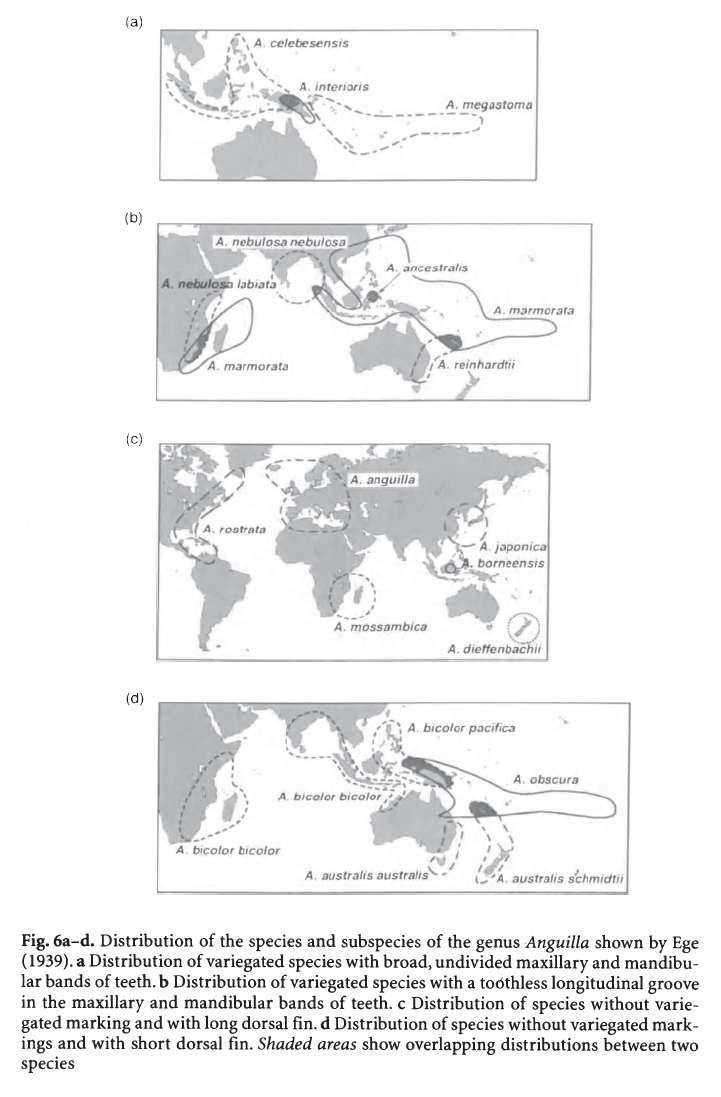
Watanabe, Shun. ‘Taxonomy of the Freshwater Eels, Genus Anguilla Schrank, 1798’. In Eel Biology, edited by Katsumi Aida, Katsumi Tsukamoto, and Katsumi Yamauchi, 3–18. Tokyo: Springer, 2003.
Righton, David, Kim Aarestrup, Don Jellyman, Phillipe Sébert, Guido van den Thillart, and Katsumi Tsukamoto. ‘The Anguilla Spp. Migration Problem: 40 Million Years of Evolution and Two Millennia of Speculation’. Journal of Fish Biology 81, no. 2 (2012): 365–86. https://doi.org/10/f35nf8.
Righton, David, Kim Aarestrup, Don Jellyman, Phillipe Sébert, Guido Van Den Thillart, and Katsumi Tsukamoto. ‘Extreme Swimming: The Oceanic Migrations of Anguillids’. In Swimming Physiology of Fish, edited by Arjan P. Palstra and Josep V. Planas, 19–44. Berlin: Springer, 2013.
The traditional eel fishery at Lake Condah and its historical and cultural significance to the Gunditjmara people.
Rose, Denis, Damein Bell, and David A. Crook. “Restoring Habitat and Cultural Practice in Australia’s Oldest and Largest Traditional Aquaculture System.” Reviews in Fish Biology and Fisheries 26, no. 3 (September 1, 2016): 589–600. https://doi.org/10/gf7spf.
Issues
- non-cuddly species
- moral status (sentience, pain)
- hard-to-study systems (ocean as a hard-to-access environment, large size)
- distributed systems (connectivity and reproductive migrations)
- forms of life in need of drastic reframing (from food to kin)
- long-duration systems
- loss of cultures (e.g., eels on the river Thames have lost the culture for going upstream) 1
- need to monitor all stages of complex life histories (but there are successful citizen science examples)2
Food
Kemmerer, Lisa. “Ethics and Eating Fishes.” Journal of International Wildlife Law & Policy 19, no. 3 (2016): 203–18. https://doi.org/10/g3xnkt.
Kemmerer, Lisa. “If You Care About Anymals, Do Not Fish (or Eat Fishes) *.” In New Omnivorism and Strict Veganism, edited by Cheryl Abbate and Christopher Bobier, 179–97. New York: Routledge, 2023.
Evolution
Evolution of the eel – a matter of continental drift
Movement Ecology
Station keeping takes place within the home range of the animal and corresponds to simple movements for foraging and predation avoidance.
Ranging and migration occur outside the home range.
Ranging: the search for a resource (mate, food, etc.). Stops when the resource is found.
Migration: triggered by physiological and environmental cues and not by the search for a resource. It affects most individuals in the population, occurs over a long timescale, requires orientation and suggests a return journey.
Diadromous fish, such as eels, undergo two long migrations.
From the spawning grounds to growth habitat, includes active upstream migration in river catchments during the early years of their continental life stage.
During the second migration eels return to the oceanic spawning grounds from their growth habitats in rivers or coastal waters.
Eels may also move between different habitats during their continental stage, movements which correspond to station keeping and ranging.
Drouineau, Hilaire, Caroline Durif, Martin Castonguay, Maria Mateo, Eric Rochard, Guy Verreault, Kazuki Yokouchi, and Patrick Lambert. “Freshwater Eels: A Symbol of the Effects of Global Change.” Fish and Fisheries 19, no. 5 (2018): 903–30. https://doi.org/10/gns2r3.
Sentience and Cognition
There is quite a bit of research on the Japanese eel behaviour by Watanabe, e.g.:
Watanabe, Shigeru. “Spatial Learning in Japanese Eels Using Extra- and Intra-Maze Cues.” Frontiers in Psychology 11 (2020): 01350. https://doi.org/10/g5twt7.
Geographies
European
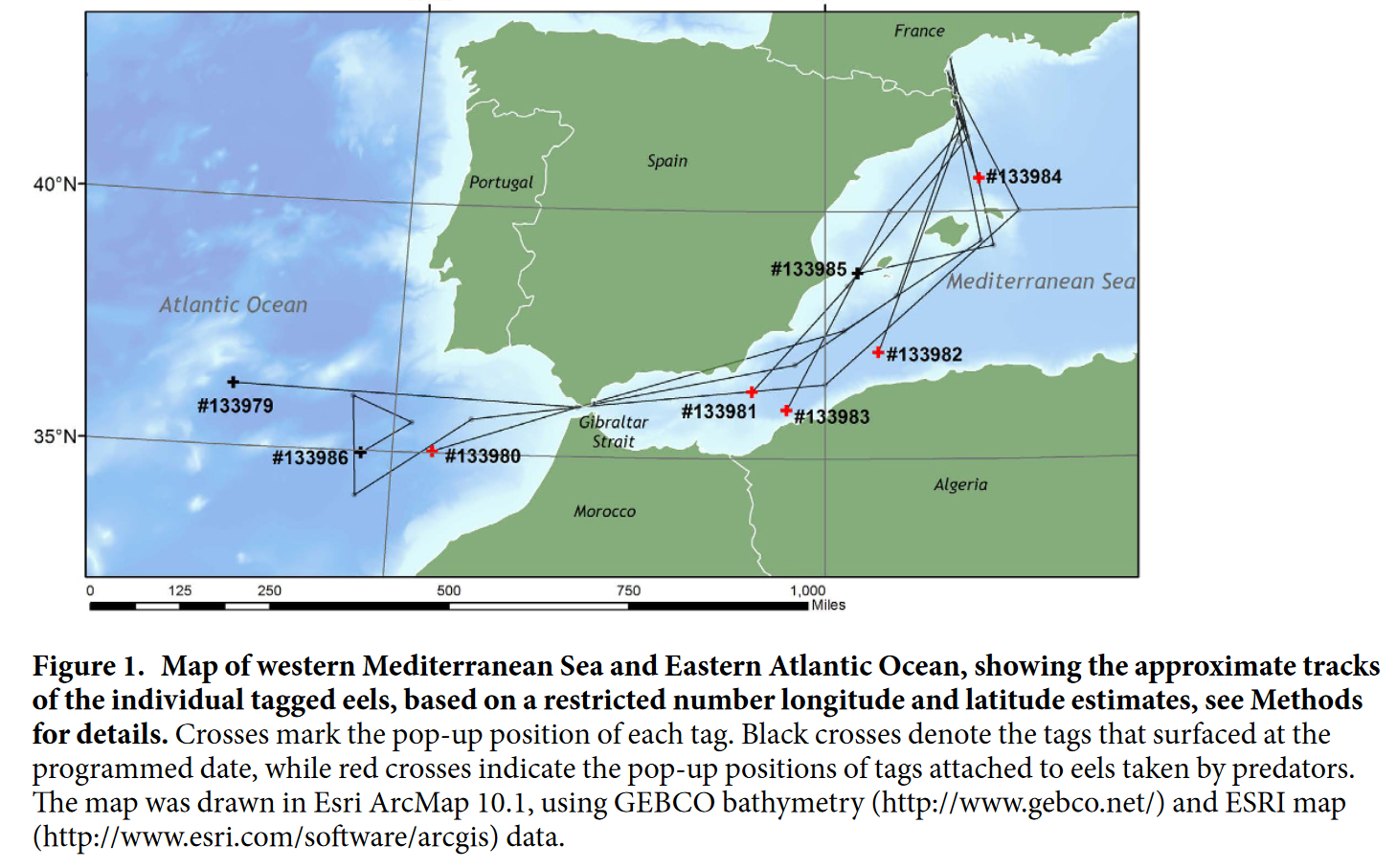
Confirms the importance of the Mediterranean rivers.
Amilhat, Elsa, Kim Aarestrup, Elisabeth Faliex, Gaël Simon, Håkan Westerberg, and David Righton. ‘First Evidence of European Eels Exiting the Mediterranean Sea During Their Spawning Migration’. Scientific Reports 6, no. 1 (2016): 21817. https://doi.org/10/f9k7gm.
Australian
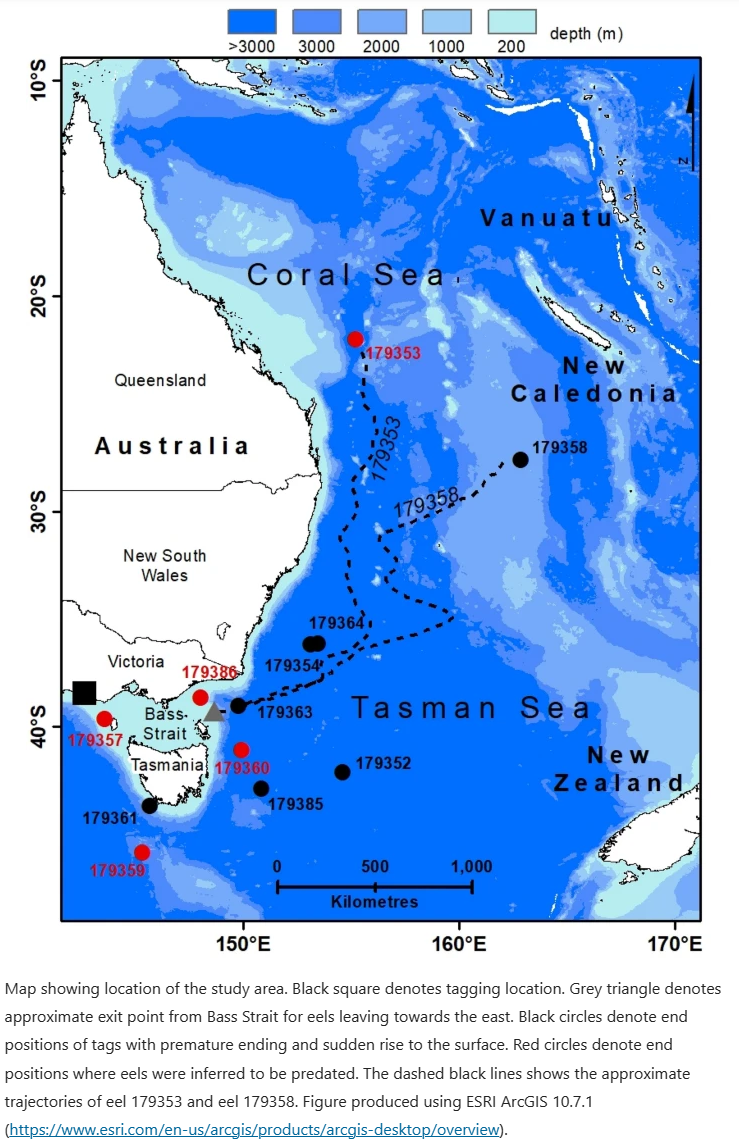
Koster, Wayne M., Kim Aarestrup, Kim Birnie-Gauvin, Ben Church, David Dawson, Jarod Lyon, Justin O’Connor, et al. ‘First Tracking of the Oceanic Spawning Migrations of Australasian Short-Finned Eels (Anguilla australis)’. Scientific Reports 11, no. 1 (2021): 22976. https://doi.org/10/gn77qh.
Is this Australia's most hardcore animal?
Eels can travel over land, climb walls and take down serious prey. They are also known as catadromous, which means they live in freshwater but migrate to the ocean to breed. There are two common eel species in Australia: the short-finned eel (Anguilla australis) and the long-finned eel (Anguilla reinhardtii). Both species spawn in the Coral Sea, near the Great Barrier Reef, after swimming thousands of kilometres from the east coast of Australia and New Zealand. This is one of the most epic migrations known within Australian waters, but the exact location of their breeding grounds remains a mystery. Scientists are trying to track eels with satellites to understand their migration better. Eels can live for decades in freshwater or estuaries before they return to the ocean to breed once and die. They are an important food source for many animals, such as sharks and whales, as well as humans4. Eels are also culturally significant for some Indigenous groups, who have been harvesting them for thousands of years.
Fishing
In Victoria, there is finishing for eels and a 2017 management plan.
Eels of Elizabeth Street in Melbourne
(Jefa Greenaway, Judith Alcorn, Mark Gillingham, landscape architect)
Wurundjeri elder Dave Wandin reckons eels moving through Melbourne drains is an urban legend, but he’s not about to rule it out completely.
One eel of a story: the slippery truth of a fishy underground migration (The Age)
American
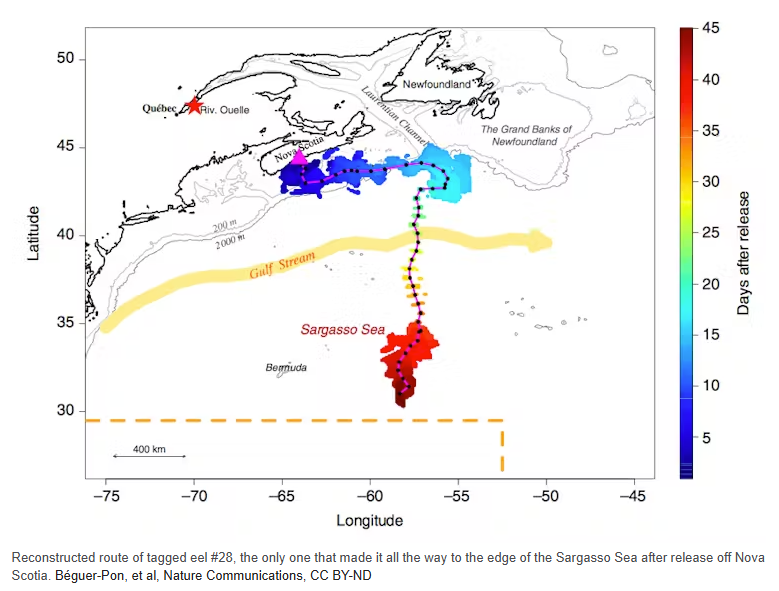
Tracking American eels on the open sea to crack the mystery of their migration
Human Impact
Drouineau, Hilaire, Caroline Durif, Martin Castonguay, Maria Mateo, Eric Rochard, Guy Verreault, Kazuki Yokouchi, and Patrick Lambert. ‘Freshwater Eels: A Symbol of the Effects of Global Change’. Fish and Fisheries 19, no. 5 (2018): 903–30. https://doi.org/10/gns2r3.
Rose, Denis, Damein Bell, and David A. Crook. ‘Restoring Habitat and Cultural Practice in Australia’s Oldest and Largest Traditional Aquaculture System’. Reviews in Fish Biology and Fisheries 26, no. 3 (1 September 2016): 589–600. https://doi.org/10/gf7spf.
Turbines
Buysse, David, Ans M. Mouton, Maarten Stevens, Tom Van den Neucker, and Johan Coeck. ‘Mortality of European Eel After Downstream Migration Through Two Types of Pumping Stations’. Fisheries Management and Ecology 21, no. 1 (2014): 13–21. https://doi.org/10/gswm6h.
Human-Eel Relationships
Harris, Cornelia B., Alandeom W. Oliveira, Brett L. M. Levy, Alan R. Berkowitz, and Chris Bowser. ‘The Eel Connection: Developing Urban Adolescents’ Sense of Place Through Outdoor Interactions with a Local Organism’. The Journal of Environmental Education 54, no. 4 (2023): 241–64. https://doi.org/10/gswmzr.
Jensen, Casper Bruun. ‘The Anthropocene Eel: Emergent Knowledge, Ontological Politics and New Propositions for an Age of Extinctions’. Anthropocenes – Human, Inhuman, Posthuman 1, no. 1 (2020): 1–11. https://doi.org/10/gswkph.
Boswell, Anna. “The Sensible Order of the Eel.” Settler Colonial Studies 5, no. 4 (2015): 363–74. https://doi.org/10/g4jpm5.
As Food
Prohibitions on the use as food:
Leach, B. Foss, Janet M. Davidson, and Fiona J. Teal. “Freshwater and Marine Eels in the Pacific and New Zealand: Food Avoidance Behaviour and Prohibitions.” Archaeofauna 31 (2022): 11–56. https://doi.org/10/g62jv9.
Japan
In 2012: "The Japanese nation has a long history of using freshwater eels as food, and these days up to ~100,000 t of eels per year are consumed there, about 70 % of the world’s eel consumption."
Kuroki, Mari, Martien J. P. van Oijen, and Katsumi Tsukamoto. “Eels and the Japanese: An Inseparable, Long-Standing Relationship.” In Eels and Humans, edited by Katsumi Tsukamoto and Mari Kuroki, 91–108. Tokyo: Springer, 2014.
Matsushige, Kazuki, and Yusuke Hibino. “Exploring Recent Japanese Public Perception of Freshwater Eels of the Genus Anguilla Using Content Analysis of Newspaper Coverage.” Aquatic Conservation: Marine and Freshwater Ecosystems 35, no. 7 (2025): e70164. https://doi.org/10/g9s22g.
Hamidoghli, Ali, Jinho Bae, Seonghun Won, Seunghan Lee, Dae-Jung Kim, and Sungchul C. Bai. “A Review on Japanese Eel (Anguilla japonica) Aquaculture, with Special Emphasis on Nutrition.” Reviews in Fisheries Science & Aquaculture 27, no. 2 (2019): 226–41. https://doi.org/10/g9s24h.
Fishing, Aquaculture, and Trade
Alonso, Aitor Ibáñez, and Daan P. van Uhm. “The Illegal Trade in European Eels: Outsourcing, Funding, and Complex Symbiotic-Antithetical Relationships.” Trends in Organized Crime 26, no. 3 (2023): 293–307. https://doi.org/10/gt76v8.
Yuan, Yuan, Yongming Yuan, Yunyun Dai, Yunchong Gong, and Yiqun Yuan. “Development Status and Trends in the Eel Farming Industry in Asia.” North American Journal of Aquaculture 84, no. 1 (2022): 3–17. https://doi.org/10/gjkbmp.
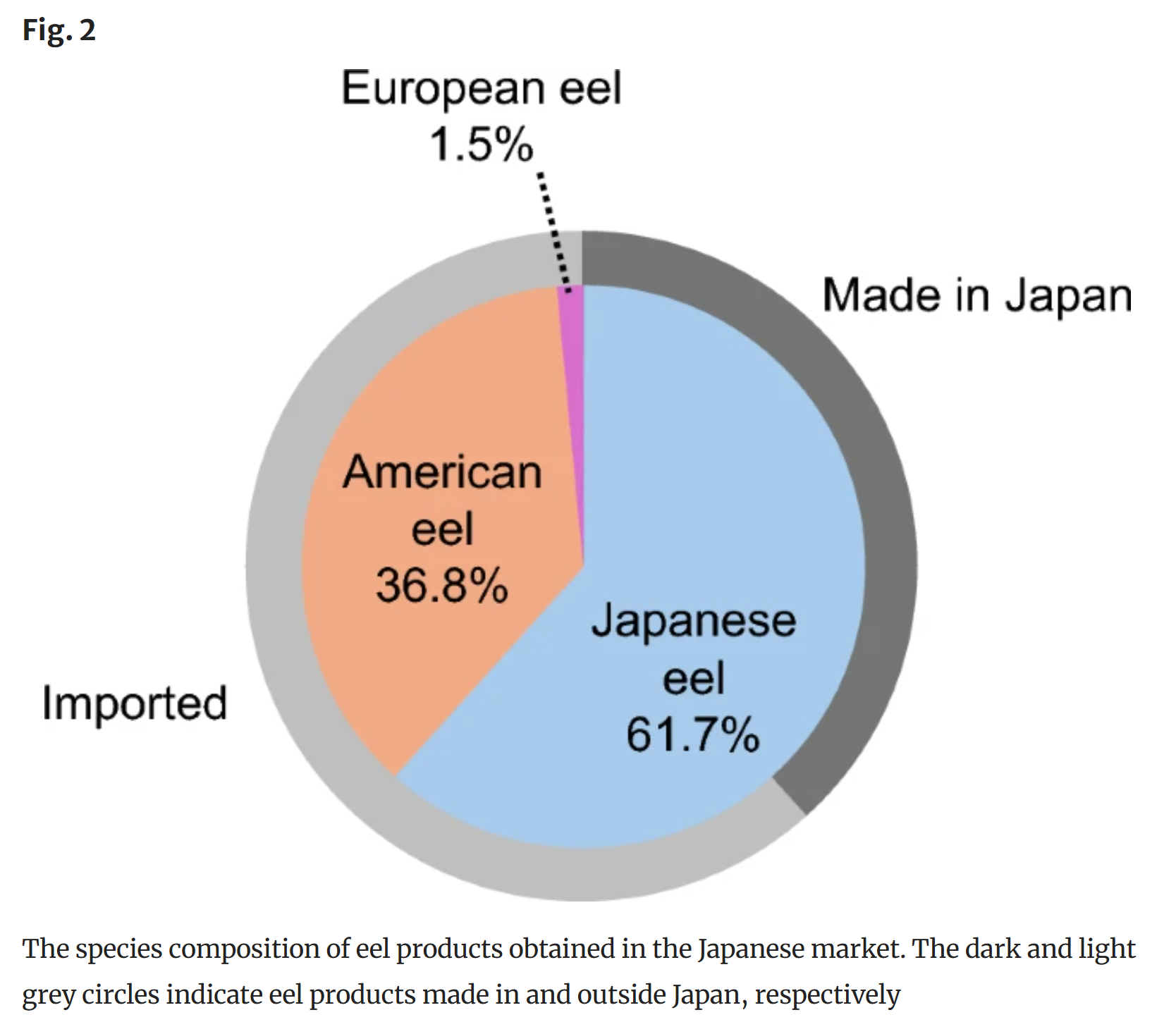
Shiraishi, Hiromi, Yu-San Han, and Kenzo Kaifu. “Eel Consumption in Japan: Insights from Genetic Species Identification and Trade Data.” Fisheries Science, 2025. https://doi.org/10/g9s27z.
Design and Conservation Initiatives
Measures:
- remove barriers to migration, fish pass design, guidance on pass design (UK), advice on passes and other measures (UK), commercial services, eel tiles
- raise public awareness about the importance of safeguarding eel habitats
Organisations:
Welfare, Sentience, Stress, and Pain
Cf. Aquaculture, Welfare, and Ethics
There is literature on neck cutting and electrocution of eels in slaugher.
Welfare implications of live chilling and freezing of farmed eels including the time to reach unconsciousness, based on ECGs and pain responses.
Lambooij, Elbert, Jan Willem van de Vis, Robert Jan Kloosterboer, and Cornelis Pieterse. “Welfare Aspects of Live Chilling and Freezing of Farmed Eel (Anguilla anguilla L.): Neurological and Behavioural Assessment.” Aquaculture 210, no. 1 (2002): 159–69. https://doi.org/10/b2p6gb.
Farmed and wild-caught eels may be exposed to many stressful and painful experiences, including injuries and mortalities.
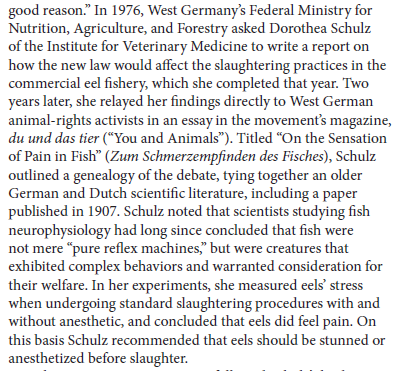
Vettese, Troy, Becca Franks, and Jennifer Jacquet. “The Great Fish Pain Debate.” Issues in Science and Technology 36, no. 4 (2020): 49–53.
Trafficking
Pons-Hernandez, Monica. “‘Missing the Trees for the Forest?’ An Analysis of the Harms to European Eels Caused by Their Trafficking and Trade.” Critical Criminology 32, no. 1 (2024): 77–95. https://doi.org/10/gt9fjn.
Pons-Hernandez, Monica. “Inside the Slippery World of Glass Eel Trafficking: Lessons Learned from Spain to Prevent the Illegal Trade of European Eels.” European Journal of Criminology, 2024, 14773708241262885. https://doi.org/10/gt9fjq.
Research Approaches
Humanities
Some references on ethnographic and similar approaches to hidden and watery creatures.
Alaimo, Stacy. “The Anthropocene at Sea: Temporality, Paradox, Compression.” In The Routledge Companion to the Environmental Humanities, edited by Ursula K. Heise, Jon Christensen, and Michelle Niemann, 153–61. London: Routledge, 2017.
Bastian, Michelle. “Whale Falls, Suspended Ground, and Extinctions Never Known.” Environmental Humanities 12, no. 2 (2020): 454–74. https://doi.org/10/gmwpvq.
Hale, Sadie E. “On Sharks Unseen: Oceanic Non-Encounters and Multispecies Ethnography.” Swamphen: A Journal of Cultural Ecology (ASLEC-ANZ) 10 (2024). https://doi.org/10/gt73sk.
Mueller, Martin Lee. Being Salmon, Being Human: Encountering the Wild in Us and Us in the Wild. White River Junction: Chelsea Green Publishing, 2017.
Swanson, Heather Anne. “Methods for Multispecies Anthropology: Thinking with Salmon Otoliths and Scales.” In Multiple Nature-Cultures, Diverse Anthropologies, edited by Casper Bruun Jensen and Atsuro Morita, 81–99. Berghahn Books, 2019.
Sciences
- genetic analysis
- eDNA
- satellite tags
- acoustic tags
- stable isotope analysis
- comparative morphology
- behavioural observation
- stomach content analysis
Mapes, Murray, and Emma Mouillot. “Taxonomic Challenges and Advances in Eel Family Classification: Integrating Multidisciplinary Approaches.” FishTaxa - Journal of Fish Taxonomy 29 (2023): 24–35.
See Data Acquisition
Proposals and Future
Gansworth, Kristi Leora, and Christopher H. Bowser. “An Anguillid Lens: How Eels Reconnect People and Waterways.” Frontiers in Human Dynamics 5 (2024): 1270644. https://doi.org/10/g3xfxw.
Videos
Life History and Migration
We Finally Know Where Eels Come From
ABC Catalyst S12E25 Eel Migration
Freshwater Eels Can Travel Through Land To Reach The Ocean
Conservation
Saving Europe’s endangered eels
Farming (aka Exploitation)
Why Japanese Eel Is So Expensive
The whole Process of an Eel farm
Food (aka Killing)
Chef Kanejiro Kanemoto Is Japan's Grilled Eel Master — Omakase
How an Eel Farm Grows and Smokes Eels for Top Sushi Restaurants — Dan Does
Smuggling
The Black Market for Eels is Exploding
Fishing (aka Killing or Harassing)
To sad to include...
Projects, Law, and Policy
DIASPARA Project: Unlocking the secrets of Europe's endangered Eel and Salmon
Stein, Florian Martin, Vincent Nijman, Mickey Chung Wai Lau, and Willem Dekker. “Eels: Uncertain Impacts of Proposed CITES Listings.” Oryx 59, no. 1 (2025): 12–13. https://doi.org/10/g9s22k.
Interspecies Relationships
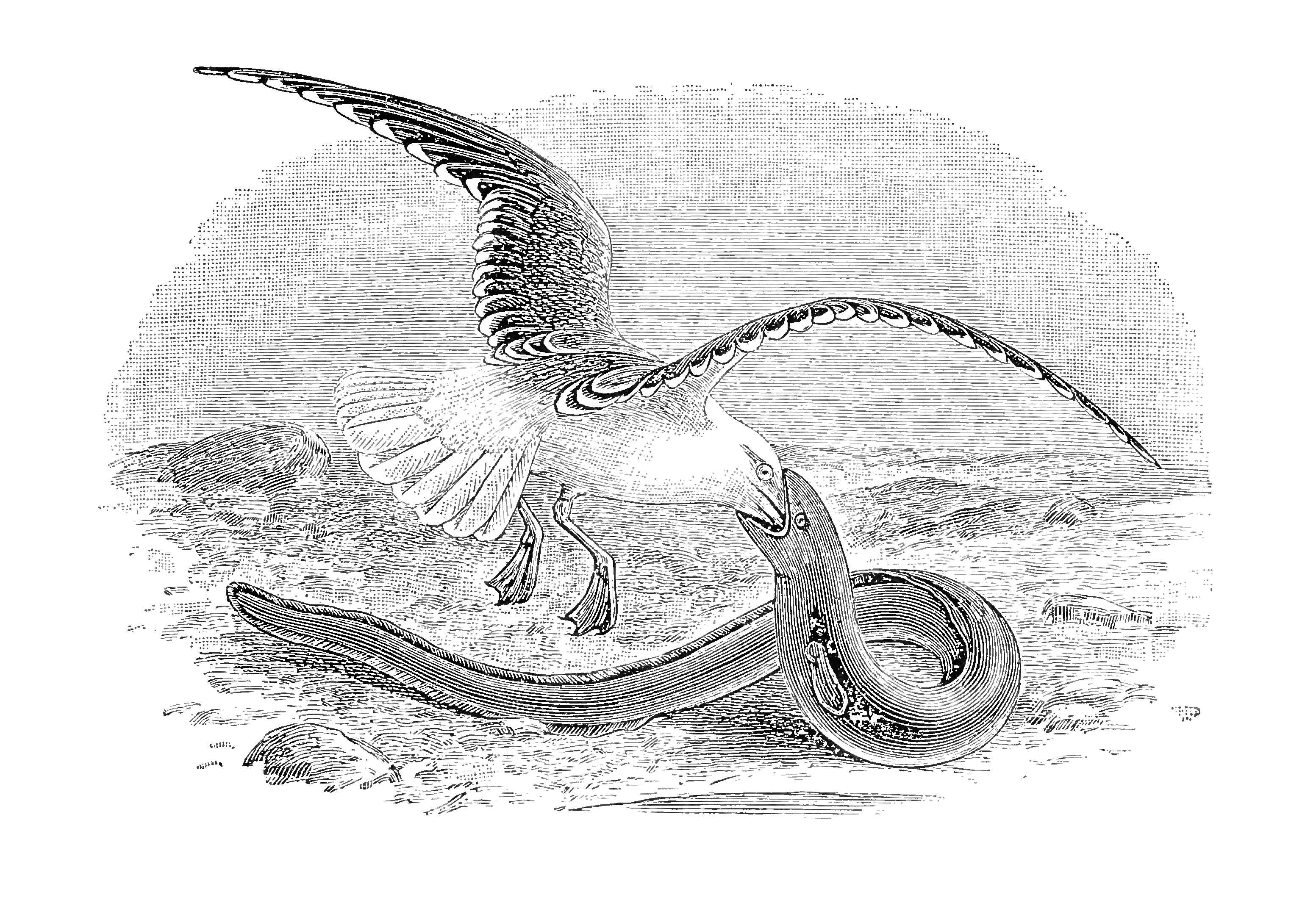
"The Biter Bit, (an incident of Bird-life in New Zealand)"
A Classified List of Mr. S. William Silver’s Collection of New Zealand Birds. With Walter L. Buller. London: E. A. Patherick and Co., 1888, p. 40.

Hosie, E. R. “Cormorant and Eels.” Emu 19, no. 3 (1920): 246. https://doi.org/10/bb747n.

Thomson, Donals. “Cormorant and Eels.” Emu 19, no. 3 (1920): 247. https://doi.org/10/bb747n.
Relationships with Humans
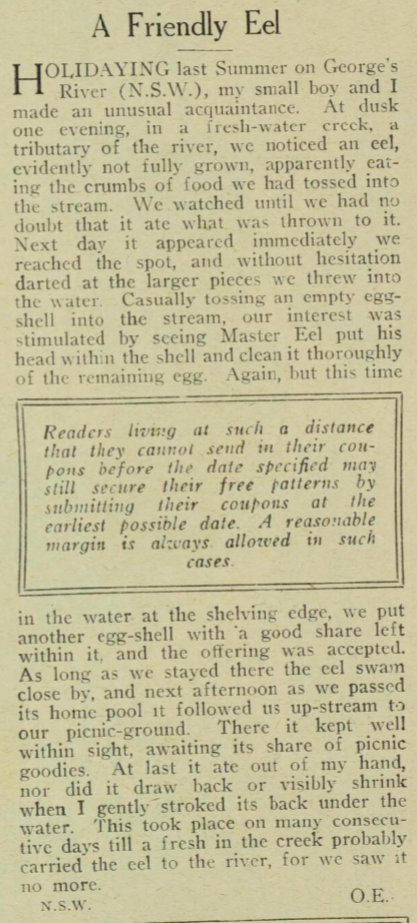
A Friendly Eel (16 October 1928)
Images
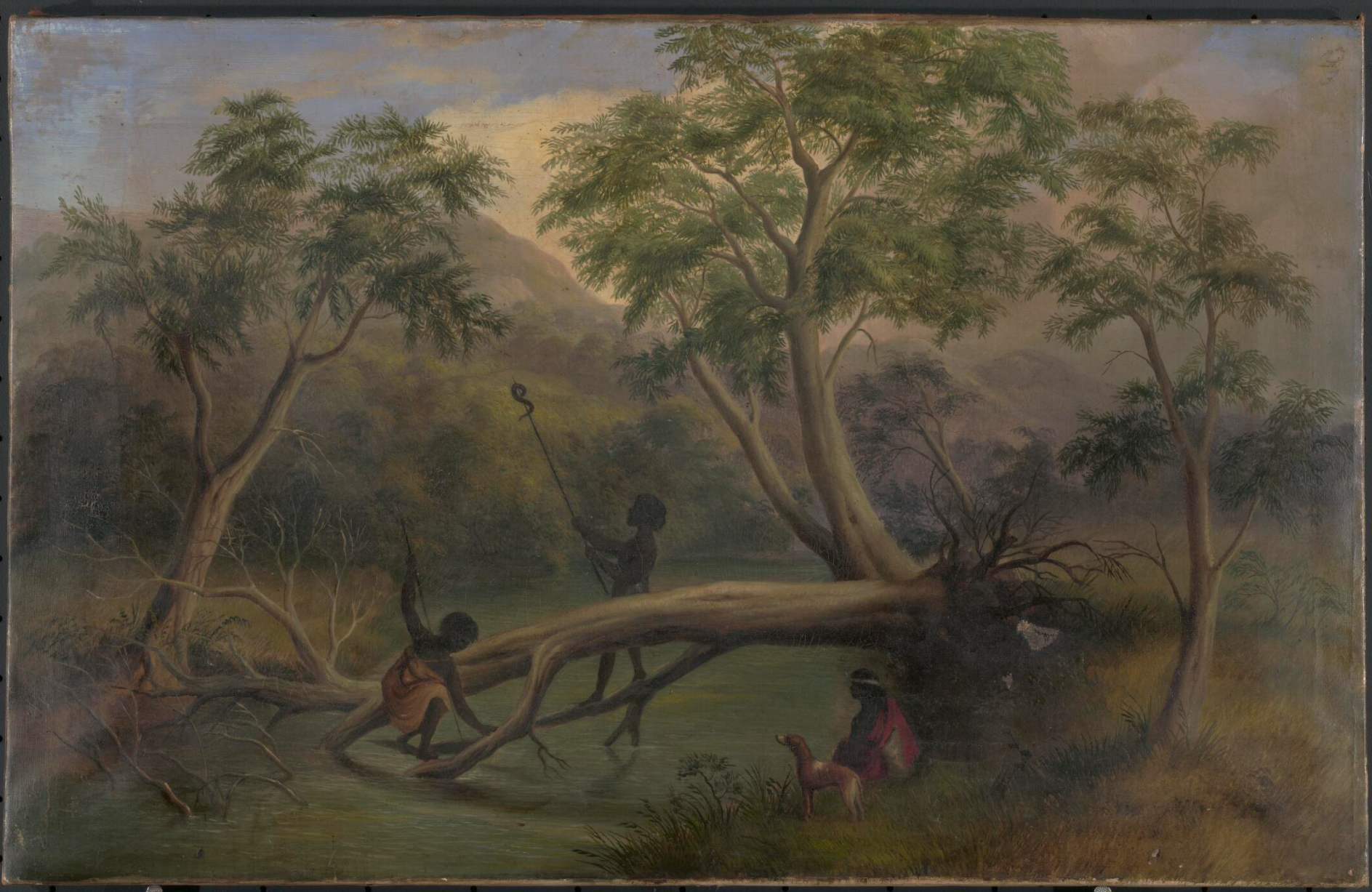
Knights, S. (Samuel Salkeld) (1852). Natives spearing eels, on Back Creek, 1852.
References
Arai, Takaomi, ed. Biology and Ecology of Anguillid Eels. Boca Raton: CRC Press, 2016.
Fort, Tom. The Book of Eels: Their Lives, Secrets and Myths. Glasgow: William Collins, 2020.
Jellyman, Don J., and Andrew I. Stewart. ‘First Record of Male Freshwater Eels (Anguilla dieffenbachii) Caught at Sea’. New Zealand Journal of Marine and Freshwater Research 53, no. 2 (2019): 288–91. https://doi.org/10/gswndr.
Prosek, James. Eels: An Exploration, from New Zealand to the Sargasso, of the World’s Most Amazing and Mysterious Fish. New York: Harper, 2010.
Schweid, Richard. Eel. London: Reaktion, 2009.
Svensson, Patrik. The Book of Eels: Our Enduring Fascination with the Most Mysterious Creature in the Natural World. New York: Ecco, 2020.
Tesch, Friedrich-Wilhelm. The Eel. Edited by John E. Thorpe. Translated by Ray J. White. 3rd ed. Oxford: Blackwell Science, 2003.
Tsukamoto, Katsumi, and Mari Kuroki, eds. Eels and Humans. Tokyo: Springer, 2014.
Tsukamoto, Katsumi. Eel Science. Singapore: Springer, 2023.
Footnotes
Fort, Tom. The Book of Eels: Their Lives, Secrets and Myths. 2002. Reprint, Glasgow: William Collins, 2020. "But the elver run that had so delighted Edward Jesse, and brought the urchins out crying ‘eel-fare time’, has never been restored to its former glory. It may well be that the species’ collective awareness of safe sanctuary up the Thames system was extinguished by the barrier of London’s filth, and that the arriving infants were content with the habitat offered by the tidal sections. A study of Thames eel stocks carried out by Iain Naismith in the late 1980s indicated that the new blood penetrating upstream from the capital was nowhere near sufficient to maintain a dynamic population."˄
Pecorelli, Joe P., Kirsty H. Macphie, Charlotte Hebditch, Darry R. J. Clifton-Dey, Ian Thornhill, and Alison J. Debney. “Using Citizen Science to Improve the Conservation of the European Eel (Anguilla Anguilla) in the Thames River Basin District.” Freshwater Science 38, no. 2 (2019): 281–91. https://doi.org/10/gwmqgj.˄
Backlinks